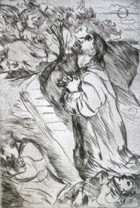Lovis Corinth
(1858-1925)
You can pass by an artist’s work for years, when, suddenly, a single, striking image will stop you in your tracks. This happened to me at the 2008 exhibition, Lovis Corinth: Between Impressionism and Expressionism, at the Musee d'Orsay in Paris. The painting was titled The Deposition (1906). There was something about the bland, indifferent face of the soldier, who stood looking on, munching a sandwich, while a second guard drew nails from the dead Christ’s feet with a huge pair of pliers that spoke volumes to me about the banality of evil.
Lovis Corinth was pushing the limits of the academic school of historical painting in which he had been trained to give the Calvary narrative a shockingly contemporary feel. I could have been there, too, just doing my job, behaving in the same calloused way. From that moment on, Corinth had my undivided attention.
I knew a fair amount about the German artist and his role as a connecting link between 19th Century and Contemporary art, how he had moved in stages from a naturalistic to an impressionistic, and finally an expressionistic style, how he was known as the “painter of the flesh,” because of his fascination with slaughterhouses and the colors of flesh and blood. Now, I had found a sacred context.
A few rooms on was an equally powerful image, which I had seen in reproduction but never associated with Corinth: Ecce Homo (1925). With brisk brush strokes, he shows a battered, beardless, modern Christ, the bleeding wounds of his bound, outstretched arms, reflecting the scarlet color of his robe. Jesus stands between a guard in medieval armor and a white-coated figure, a doctor or, perhaps, the warden of an insane asylum. The image of Christ is believed to be a self-portrait.
Since my Paris encounter with Corinth, I have been looking for more of his works with religious themes and discovered two beautiful drypoint engravings of Christ on the Mount of Olives (1915) and The Archangel Michael and two remarkable prints, Bearing the Cross (1916) and Bearing the Cross (1923). After a stroke in 1911 , Corinth began to use freer line work. His markings became broader, more energetic, often frenzied, anticipating the style of the German Expressionists.
The first version of this Stations of the Cross motif from 1916 shows the fallen Christ, addressing the women of Jerusalem. A handwritten line at the bottom of the plate, taken from Luke 23:28, reads “Weep not for me but weep for yourselves and your children.” The second 1923 study is equally expressionistic in style. The confusion of the scene, the grimacing, horror-stricken faces, and the haunting look of the fallen Christ all speak of impending doom. Corinth died two years later. Within 14 years of his death, his works would be tossed on Nazi bonfires as examples of “degenerate” art.




